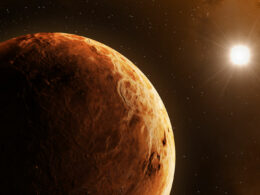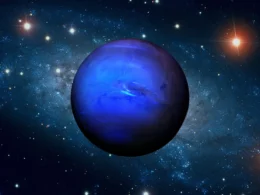One of the most interesting aspects of Jupiter is its year length, which is significantly longer than Earth’s year. A year on Jupiter is defined as the time it takes for the planet to complete one orbit around the sun. According to NASA, Jupiter’s year lasts 4,333 Earth days, which is equivalent to 11.86 Earth years. This means that Jupiter takes almost 12 Earth years to complete one orbit around the sun.
Jupiter’s Orbit and Year Length
Comparing Planetary Orbits
The length of a year on a planet is determined by the time it takes for the planet to complete one orbit around its star. In the Solar System, each planet has a unique orbital path and time. For instance, Earth takes approximately 365.24 days to complete one orbit around the Sun. In contrast, Jupiter takes about 4,332.59 Earth days, equivalent to 11.86 Earth years, to complete one orbit around the Sun.
Jupiter’s Orbital Path and Time
Jupiter’s orbit is not a perfect circle, but rather an ellipse. Its distance from the Sun ranges from 741 million km (4.95 astronomical units) at its closest point (perihelion) to 817 million km (5.46 astronomical units) at its farthest point (aphelion). This distance is much greater than Earth’s average distance from the Sun, which is about 150 million km (1 astronomical unit).
Jupiter’s axial tilt is relatively small, only about 3.13 degrees, so it does not experience significant seasonal changes like Earth does. Jupiter rotates once about every 10 hours, which is the shortest day of all the planets in the Solar System. However, it takes about 12 Earth years to complete one orbit around the Sun, which is known as a Jovian year.
Physical Characteristics of Jupiter
Jupiter is the largest planet in our solar system and is classified as a gas giant. It has a mass of approximately 1.898 x 10^27 kg, which is more than twice the mass of all the other planets in the solar system combined. Its diameter is about 11 times that of Earth, making it the fifth planet from the sun.
Atmospheric Composition
Jupiter’s atmosphere is mostly made up of hydrogen and helium, with small amounts of ammonia, water, and other compounds. The planet’s atmosphere is divided into several layers, with the outermost layer consisting of clouds that are mostly made up of ammonia ice and ammonium hydrosulfide crystals. Below this layer, there are clouds of sulfur and phosphorus compounds. Jupiter’s atmosphere is also known for its jet streams, which are powerful winds that can reach speeds of up to 620 kilometers per hour.
Moons and Rings
Jupiter has a total of 95 known moons, including the four largest moons known as the Galilean satellites: Europa, Ganymede, Callisto, and Io. These moons were discovered by Galileo in 1610 and are some of the largest objects in the solar system, with Ganymede being larger than the planet Mercury. Jupiter also has a narrow system of rings, which are mostly made up of small particles of water ice and other materials.
Magnetic Field and Core Structure
Jupiter has a strong magnetic field that is about 20,000 times stronger than Earth’s magnetic field. This magnetic field is thought to be generated by a dynamo effect, which is caused by the motion of electrically conducting material in Jupiter’s core. The planet’s core is believed to be made up of rock, metal, and hydrogen compounds, and it is surrounded by a layer of liquid metallic hydrogen.
Jupiter’s core is also thought to be the source of the planet’s strong gravitational pull, which is about 2.5 times stronger than Earth’s gravitational pull. This gravitational pull can cause intense tidal forces, which are responsible for the formation of some of the planet’s most notable features, such as the Great Red Spot, a massive storm that has been raging for hundreds of years.
Frequently Asked Questions
What is the duration of a Jovian year in Earth terms?
A Jovian year, or the time it takes Jupiter to orbit the Sun once, is approximately 11.86 Earth years long. This means that if someone were to live on Jupiter, their age in Earth years would be significantly different than their age in Jovian years.
How does Jupiter’s orbital period compare to that of Earth?
Jupiter’s orbital period is much longer than Earth’s, with one Jovian year lasting nearly 12 Earth years. Jupiter’s distance from the Sun is also much greater than Earth’s, which affects its orbital speed and length of year.
What planet in our solar system has the longest orbital period?
Neptune has the longest orbital period of any planet in our solar system, taking approximately 165 Earth years to complete one orbit around the Sun.
How does the length of a year vary across the solar system’s planets?
The length of a year varies greatly across the solar system’s planets due to differences in their distance from the Sun and their orbital speeds. For example, a year on Mercury is only 88 Earth days long, while a year on Neptune is 60,190 Earth days long.
Would a human’s perception of age change if living on Jupiter?
Yes, a human’s perception of age would change if they were living on Jupiter due to the planet’s longer orbital period. One Jovian year is nearly 12 Earth years long, so a person living on Jupiter would age much more slowly than someone living on Earth.
Which planet completes an orbit around the Sun the quickest?
Mercury completes an orbit around the Sun the quickest, with one year lasting only 88 Earth days. This is due to its close proximity to the Sun and its high orbital speed.





